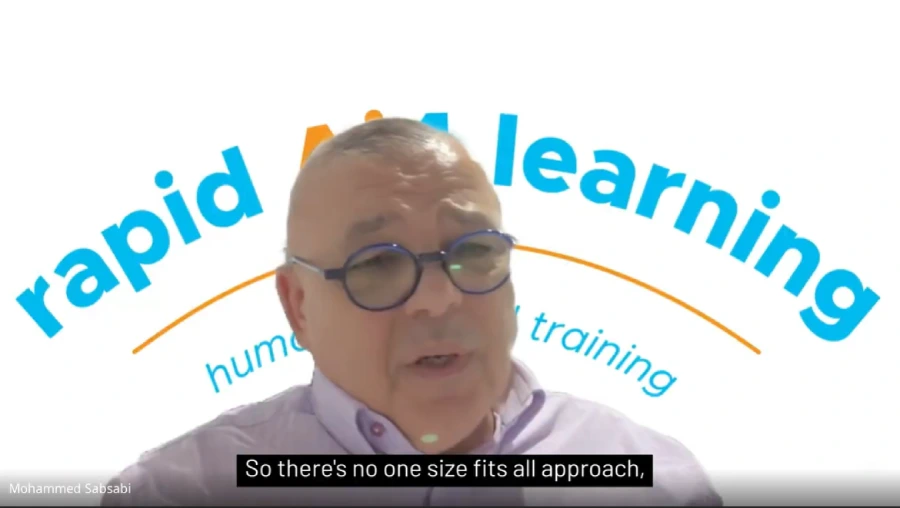AI in Schools: What to Do Before You Pick a Tool
- Published on: June 24, 2025
- |
- Updated on: June 24, 2025
- |
- Reading Time: 5 mins
- |
-
Views
- |
AI Needs to Go Beyond Efficiency
Shift Your Mindset, Not Tech Stack
A Simple, Practical Framework: REARI
Two Ways to Start Using AI—Today
1. The Specialist Tool Approach
2. The End-to-End Platform Approach
AI Assessment
What AI Adds, Not Just Replaces
How to Start
1. Identify a Small Problem
2. Find a Champion
3. Give Them Protected Time
4. Run a REARI Loop
FAQs
The last 18 months have been flooded with AI talk. Big promises. Buzzwords. Flashy demos. Everyone wants to do something with AI, but very few are asking the right question:
How does this help teachers teach and students learn?
We got in conversation with Rapid Ai4 Learning, whose mission is to build global AI literacy and competency in the education and training sector.
“We wanted to peel it back and think about how AI as a tool could be used to enhance pedagogy and enhance delivery in education settings.”
This blog captures the highlights of the interview, breaking down how schools can start building real AI capability, grounded in pedagogy, ethics, and problem-solving.
Here’s what every education leader should know right now.
AI Needs to Be More Than Efficiency Theater
The pressure is on. Employers now expect AI fluency as a baseline skill. LinkedIn has ranked it the top
in-demand competency.
“Some countries have moved faster and are really embedding AI and AI literacy now into their school curriculum and into their education system.”
Global education systems, from the U.S. and U.K. to India, Singapore, and the UAE, are weaving AI into national curricula. But inside institutions, leaders are still trying to separate the signal from the noise. They’re dealing with:
- Compliance and data privacy concerns
- Thousands of AI tools with overlapping claims
- Overworked teachers who are already drowning in tech fatigue
- Students on track to graduate into an AI-infused workforce… without being prepared for it.
That’s why we focus not just on AI as technology, but AI as literacy—a foundational skillset that can reshape how we learn, teach, and think.
Shift Your Mindset, Not Your Tech Stack
Before you pick a tool or even run a pilot, you need to shift your internal posture around AI.
Here’s what that looks like in practice:
- Adopt a mindset of exploration. Treat AI like we once treated the internet: inevitable, risky, and transformational.
- Acknowledge the risks. Bias, misinformation, and privacy aren’t side concerns. They’re part of the core implementation plan.
- Ask “Why?” before “Which?” Don’t start with a tool. Start with a problem.
- Bring your full institution. Educators, students, school leaders, and families all have a role in deciding what “responsible AI” looks like for your learning community.
We need to start building AI capability in a way that’s useful, equitable, and scalable.
A Simple, Practical Framework: REARI
Most institutions fall into one of two traps: either they overcommit to AI without a plan, or they stay frozen, unsure how to start.
“We teach people to ask those critical questions, not just to go to the AI tool straightaway, but to think deeply about what the problems are, what they’re trying to solve for.”
That’s why the founders at Rapid Ai4 Learning built REARI: a five-step, practical framework they use with institutions around the world to help them launch safe, structured AI initiatives.
| Step | What It Does |
| Research | Define the real need and who it’s for |
| Evaluate | Explore which tools and approaches best fit your context |
| Apply | Pilot it with clear guardrails and accountability |
| Revise | Review what worked, what didn’t, and why |
| Improve | Decide how to scale—or sunset—based on evidence |
REARI is non-technical. It’s built for educators and based on learning design. And it embeds critical thinking and ethics at every step, not as a checkbox but as a foundation.
Two Ways to Start Using AI—Today
A question that the interviewers face very often is: “What tools should we start with?” For each individual and entity, the answer depends. But institutions usually succeed when they take one of two clear paths:
1. The Specialist Tool Approach
Pick a well-designed tool that solves one real problem.
Example: An AI writing assistant that helps special education teams cut hours off IEP documentation.
2. The End-to-End Platform Approach
Adopt a broader solution that supports the full learning cycle.
Example: An AI tutor chatbot that answers low-level student queries so teachers can focus on higher-order instruction.
In both cases, you can run it through Rapid Ai4 Learning’s framework, REARI. Ask the right questions. Pilot with purpose. And most importantly, evaluate what it’s doing to actual learning, not just productivity metrics.
What AI Assessment Looks Like When It’s Done Right
One of the most inspiring examples of AI implementation, Rapid Ai4 Learning shares, comes from Singapore, where high school students were tasked with creating real-world solutions using AI.
One team built an AI-powered GPS app for dementia patients. To get there, they had to:
- Interview end users and caregivers
- Iterate prototypes based on feedback
- Manage their project like a startup team
- Present their work to multiple stakeholders
This was AI in education at its best: civic-minded, skill-building, and deeply human.
A pertinent question here would be: what would’ve been learned if they’d just written an essay instead?
The Hidden Upsides: What AI Adds, Not Just Replaces
When used well, AI doesn’t just save time. Dinesh and Mohammed stress the things AI enhances for education:
- Critical thinking improves. Students must vet AI outputs for bias, accuracy, and relevance. They can’t coast.
- Teacher-student relationships deepen. AI takes on the admin and “easy” queries, freeing time for richer engagement.
- Experienced educators get re-valued. Subject-matter experts—especially senior staff—can play pivotal roles as AI ethicists, trainers, and governance leads.
- New roles emerge. We’re already seeing job titles like AI Literacy Coach, AI Ethics Advisor, and Prompt Engineer become part of education org charts.
This is not about replacement. It’s about realignment and creating space for the human side of teaching to thrive.
How to Start (Without Overhauling Everything)
If your organization wants to build AI muscle, start here:
1. Identify One Small Problem
Something low-risk and meaningful—a repeatable task that drains time or clarity.
2. Find One Champion.
A teacher or staffer who’s curious about AI and hungry to try.
3. Give Them Protected Time.
One hour a day. One day a week. Whatever your structure allows.
4. Ask Them to Run a REARI Loop.
Document what happens. Share the findings. Build from there.
You don’t need a 12-month AI strategy to begin. You just need one clean experiment and a willingness to learn from it.
If you’re ready to start building real AI literacy in your institution, let’s keep the conversation going. Hear the complete discussion between Rapid Ai4 Learning and Magic EdTech, including practical tips, global case studies, and our take on what ethical AI adoption really looks like. See how Rapid Ai4 Learning is helping institutions around the world integrate AI through structured frameworks, ethical guardrails, and practical training, not product push.
FAQs
One way of measuring learning outcomes against productivity gains is to track cognitive load changes through pre- and post-implementation assessments that measure deep understanding, not task completion speed. The effective metrics could be students' ability to critique AI-generated content, improvement in higher-order thinking skills, and retention rates on complex concepts. Productivity metrics like time saved only matter if that time is redirected toward meaningful learning activities that lead to measurable academic growth.
To adapt the REARI framework for different grade levels, elementary schools need simplified Research and Evaluation phases with more teacher-led decision-making, while for high schools, students need to be involved directly in all five REARI steps.
The specific problems or tasks that can work best with the initial AI pilots are repetitive administrative tasks like progress report comments, differentiated worksheet creation, or parent communication templates, rather than core instruction.
To measure it, we can track changes in the quality and depth of teacher-student interactions, student engagement levels during AI-enhanced lessons, and whether the saved time gets redirected to meaningful instruction.

Get In Touch
Reach out to our team with your question and our representatives will get back to you within 24 working hours.

